 When I smile for photographs my face produces a grimace with an eerie resemblance to Beethoven’s death mask. Beethoven has a good excuse for grimacing – he’s dead. I’m no mortician, but it must be hard to smile while lying in deathful repose. If it was possible to smile in death, that would be disconcerting.
When I smile for photographs my face produces a grimace with an eerie resemblance to Beethoven’s death mask. Beethoven has a good excuse for grimacing – he’s dead. I’m no mortician, but it must be hard to smile while lying in deathful repose. If it was possible to smile in death, that would be disconcerting.
I have no excuse for the grimace except genetics and aging. My father has the same problem, but his condition would be best described as late-onset grimacing. Until recently his grimace was barely detectable in photographs. My condition developed much earlier in life. The corners of my mouth are beginning to droop, giving me a somewhat depressed demeanor when relaxed. When I look in the mirror (and I do this as little as possible to maintain self-esteem), I sometimes flex the corners of my mouth upward, looking for new, more pleasant positions. There are none; each adjustment makes me look like a mischievous ferret.
Fortunately, my spontaneous smiles look natural and reproduce nicely in photographs I do not know are being taken. As soon as a photograph is staged, the grimace reappears.
School pictures only add to the frustration. It does not help that our school photographer must have graduated from the Contortionist School of Photography. Each year it’s the same procedure. I sit precariously on a little stool, pull my glasses down like Granny of the Beverly Hillbillies to avoid the glare, turn my body to the left, tilt my head back to the right, put my chin down, and then look up. Then he expects me to smile naturally. The last time my body was in that position came during a game of Twister. A major grimace is inevitable.
Unfortunately, retouch technology for photos has not reached the point that it can help me. In fact, it can make things worse. Once, after having a family photo taken, a company rep asked my wife if she would like to have the shadows and wrinkles removed from her picture. She said yes and when the photos arrived weeks later, her normally photogenic likeness had been trans-formed into what could best be described as a melted Barbie head. We may have been the first family ever to return photos to have shadows and wrinkles inserted.
Digital photography has made it easier to delete the worst photos after I select the lesser of ten evils. It wasn’t long ago that within the confines of a darkroom, my grimacing image must have come forth like a creature from the black lagoon. I have found that the only way to avoid the grimace is to look stupid on purpose. When I make a stupid face, the picture looks exactly like I expect. I’m in complete control. I try not to think of the implications of this.
You may wonder what all this has to do with teaching but there is a connection based on one television news magazine I watched. The show studied if children thought good-looking teachers were better than average-looking teachers, even if the teaching methods used were the same. In interviews students did think the good-looking teachers were better even though they did nothing differently than the beauty-challenged teachers. (Students were not aware of the study’s subject matter.)
Would students think I was a better band director if I looked like a Hollywood hunk? Maybe, but what they think wouldn’t make the band sound better. I do see how it could help with recruiting. I’ve thought about having Johnny Depp or Justin Bieber portray me during recruiting. Then the next fall I can tell the beginners I was in an accident and had an extreme makeover gone wrong.
I’m comforted that many famous composers seem to have been affected with the same grimacing malady and it didn’t stop them from gaining a measure of immortality. I guess there’s even hope for me; however, no matter what happens, I think I’ll avoid having a death-mask procedure.






